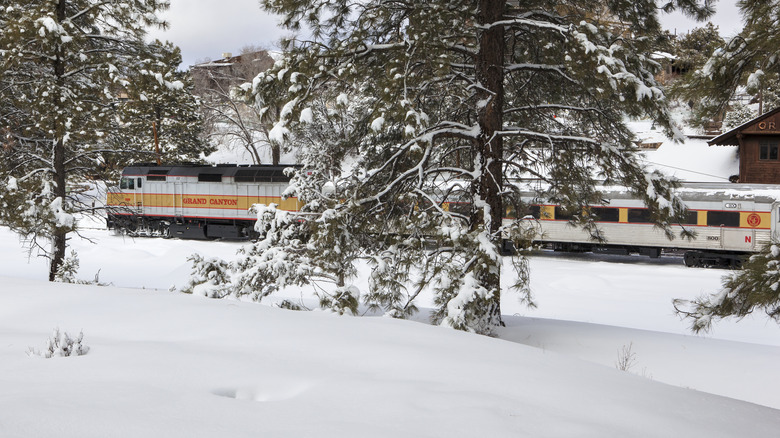Grand Canyon National Park Is The Highlight Of This Scenic, Round-Trip Winter Train Ride
Any train ride through the snow is already enchanting. No matter where you're going, there's nothing like the sight of frozen bluffs whisking past your window. The inside of a train car is warm and snug, and your only obligation is to relax and sip something warm — and probably take a few pictures of the winter wonderland outside. These kinds of cold-weather rides recall such romantic journeys as the Orient Express, back in the day when trains served as a kind of mobile resort. The very concept of a train feels novel and vintage to most Americans, and the snowy scenery just screams "holiday season."
Now add the Grand Canyon. Suddenly, the folksy magic goes into overdrive. First, you absorb the evergreen-studded landscape of the high desert, then you arrive at one of the greatest natural wonders in the world. This is what winter riders on the Grand Canyon Railway experience: a two-plus-hour expedition from Williams, Arizona, to the Grand Canyon. Then, once you've walked the precipice and gotten your fill of this mile-deep chasm, you can hop aboard the train and head back. But even then, the magic continues; the Grand Canyon Railway isn't just a train but also a hotel in town, and guests are welcome to stay in its luxury rooms as well.
This is a spellbinding part of the country, and a scenic road trip route to the Grand Canyon is honestly just as gorgeous as the destination. If you're coming here in the winter, you benefit from thinner crowds and unique views — plus you get to skip the Southwest's legendary heat. After driving so far, the Grand Canyon Railway lets you ditch the car and just take it all in.
How the Grand Canyon Railway came to be
Arizonans are no strangers to trains. Back when this part of the country was the "Arizona Territory" — and a very literal "Wild West" — railroads played an important part in mining and town-building. Even today, Amtrak's Southwest Chief Line is a vital artery, connecting the Midwest to California and running right through Arizona. Like other rail lines across the country, many of these tracks were abandoned and fell into disrepair.
Luckily, the Grand Canyon Railway was rescued from this fate. Opened in 1901, this route was originally a 60-mile freight line, under the tutelage of the Santa Fe Railroad. Even then, the scenic corridor was known as "The Gateway to the Grand Canyon," and the conspicuous location wasn't lost on railroad investors. Passenger trains were quickly added, and soon turn-of-the-century tourists were venturing out to Williams to see the canyon in person. The Railway built its own hotel, which remains the oldest accommodation in town. The train ground to a halt in 1968, and it wasn't until a pair of entrepreneurs, Max and Thelma Biegert, took over the defunct line that the Grand Canyon Railway was revived. The modern tourist train has operated continuously since 1989.
The train rides are fun and historic, but they also serve a practical purpose: cutting down on auto traffic. The Railway spares the Grand Canyon an estimated 50,000 car-visits each year, which cuts down on gridlock, parking, and air pollution. This is the main reason the Grand Canyon is one of the beautiful U.S. national parks you can explore without the need of a car.
How to enjoy the Grand Canyon Railway
Like the Grand Canyon itself, the town of Williams is pretty far out there. The closest airport is Phoenix Sky Harbor International, which is nearly three hours away by car, with potential pitstops in Sedona and Flagstaff. You could also fly into Harry Reid International in Las Vegas; the drive is about three and a half hours, but you can swing by the Hoover Dam along the way. There is a Greyhound stop here, although the "station" is technically a McDonald's parking lot.
Williams itself is a small Arizona town with unique retro charm, and it's a logical place to stay the night during a Grand Canyon visit, whether you hop the railway or not. The train departs just about every day at 9:30 a.m., although it starts an hour earlier in November and December. If you're coming in the winter, dress in layers; South Rim temperatures fall well below freezing, and the ground receives an average of 58 inches of snow each year. The summer train is famous for its pre-ride gunfight, live music on board, and mid-route robbery by masked cowboys.
Come Christmastime, the train transforms into The Polar Express, a kid-friendly homage to the picture book by Chris Van Allsburg. The cars are decked with ribbons, fir trim, and colorful lights, and Santa makes a boisterous cameo. Tickets start at $62 for adults and $48 for children. Note that the Polar Express route is only 90 minutes and doesn't go always the way to the Grand Canyon Historic Village. Even after the Polar Express has passed, the train continues to chug through the snow, just as it did a century ago.


